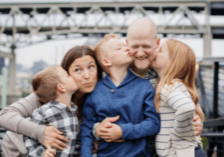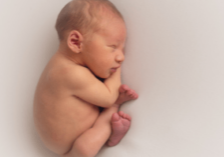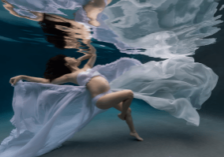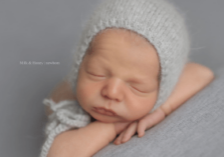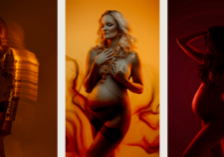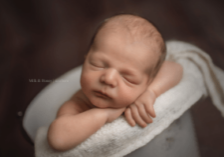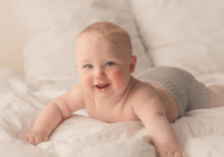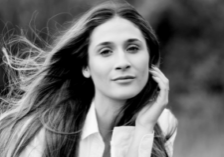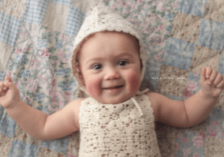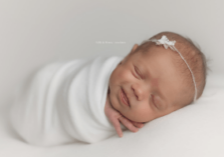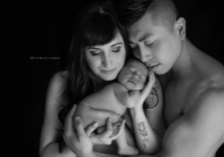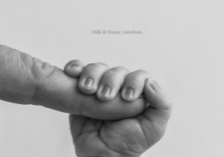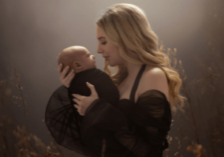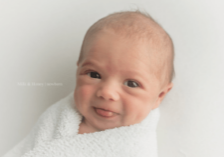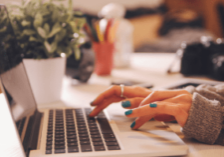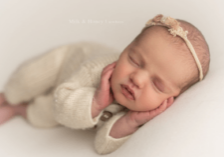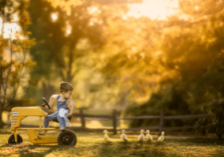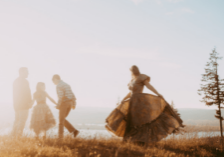Scroll-stopping Storytelling: Creating Fine Art Children’s Portraits with Photographer Iwona Podlasinska
Iwona Podlasinska started her career as an architect, but once she became a mother, she discovered her newest inspiration: her children. That prompted her to pivot into the world of photography, and she’s been honing her creative craft ever since!
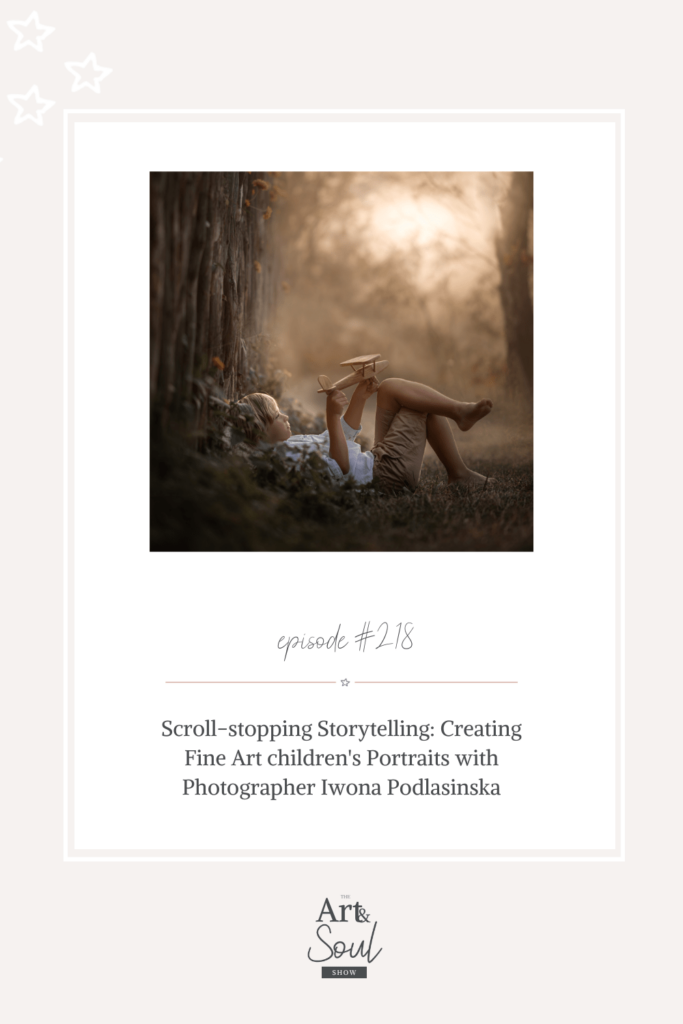
In today’s episode, Iwona and I chat about her incredible career as she’s focused on fine art children’s portraiture and educating other photographers. We dive into how she’s developed her own eye-catching style, how she thinks about composition, and the way she directs her clients to capture just the right mood in every portrait.
We also touch on some hot button topics, like how Iwona is using AI tools to enhance her work these days and how she bounced back from one of a photographer’s worst nightmares: losing access to a social media account that helps you promote your business!
If you’ve ever wanted to dip your toes into fine art photography, you can’t miss this episode. Let’s dive in!
What’s in this episode:
- [03:27] Iwona shares how she got her start in photography and why she focused on education early
- [05:41] How Iwona uses social media and how she rebuilt after losing her Instagram account
- [12:42] What inspires Iwona and how she’s created her signature style
- [18:27] How Iwona manages traveling for her work as a photographer with two small children at home
- [25:31] How Iwona sets the mood in her photography sessions through composition choices and direction for her clients and models
- [41:09] The new teaching models Iwona is working on to continue educating other photographers
Tune in to this episode to learn how Iwona Podlasinska crafts her magical fine art children’s portraits!
SUBSCRIBE: Apple Podcasts | Spotify
Want to put an end to awkward moments in your photo sessions and create genuine connection? Download The Storyteller’s Toolkit today, featuring 200+ emotive photography prompts, so you’re never left wondering what to say.
Resources Mentioned
Meet Iwona Podlasinska
Iwona Podlasinska began with taking pictures of her kids in 2014 and then slowly moved to take photos of other children. She could describe her work as something between reality and a dream. She loves deep tones and glorious light, and pays a lot of attention to composition and mood in her work.
She loves sharing her knowledge and passion with other photographers worldwide. She started traveling with workshops in 2016 and has already visited 14 European countries, the USA, Brazil, and China. She also shares her editing techniques online. Her goal is to share her passion and show other mothers and photographers how to see the magic in everyday life. She has been awarded in many international contests and became the most famous photographer on Flickr in 2017 and an IPA photographer of the year in 2020 (Still in Motion category).
Connect with Iwona
Did this episode with Iwona Podlasinska inspire you to try out fine art photography ? Check out this episode Finding your Artistic Voice with Fine Art Photographer Shannon Squires that shares how another photographer started their career!
Transcript
[00:00:00] Lisa DiGeso: [00:01:00] Welcome to the Art and Soul Show, where we dive into heart opening chats on photography, business, life, and that messy in between. I’m your host, Lisa DiGeso, a mom, a photographer, and entrepreneur. And I’ll be sharing honest conversations and advice for photographers, with insight on mindset, creativity, and creativity.
[00:01:21] Entrepreneurship and creativity. The goal of this podcast is for you to be able to gain insights and strategies that will get you real results. Because let’s face it, having a photography business can be lonely, but it doesn’t have to be. This is the place you can go when you need a boost of encouragement, a kick in the pants and inspiration to pick up your camera.
[00:01:43] This is the art and soul show. Hello, my beautiful friends. Welcome back to the show today. I am super excited to dive into today’s conversation with Iwona Podlasinska. Sorry, I know I tried really hard on that. Well, she has a [00:02:00] very big name, but she has an even bigger reputation. She is probably one of my favorite fine art photographers.
[00:02:06] Especially in the genre of storytelling children’s photography, and I first met her back way in 2016 when I actually booked a one on one mentoring session with her, and she’s actually taught for the Milky Way, too. So I am so excited to chat with her. I hope to bring her back to the Milky Way again. Her work is both nostalgic and it’s as perfect Blend of this expert level of color grading, creative use of textures and overlays, and she’s just an amazing creative force.
[00:02:33] So I’m really excited to dive into today’s conversation. So welcome. Yeah, I’m so happy
[00:02:40] Iwona Podlasinska: to be here. And yes, we’ve met before we’ve worked together. But it was a long time ago. Long time ago. I am. I’ve been listening to the podcast and for quite some time right now. And I actually I used to listen to that and I stopped a little then you brought it back in because you are so smart with how you Post [00:03:00] those reels with those like most interesting parts of your podcast.
[00:03:03] And I, and I just grabbed me and then I got back go and I said, oh, I would love to be a guest on your podcast. And then you contacted me that. Yay. I love it. Well,
[00:03:13] Lisa DiGeso: I’m so excited to chat with you because I just love watching your work on social media because it’s a scroll stopper. And would love if you just share a little bit about your journey into photography, how you got into it, and sort of where you’re at now.
[00:03:27] Iwona Podlasinska: So I started with my, you remember you mentioned 2016, so I think I started like 2014. Yeah. I started with my own children. I’m an architect. I used to be, I used to work as an architect for 10 years before I started doing photography. I liked photography before, but I never knew what, what to photograph. I like, you know, flowers.
[00:03:49] Landscapes. Yeah. And it was like, I was never passionate about any of those things. And then I got my, I had my children and then I finally discovered my, my favorite subject. [00:04:00] And then I started looking for those of my kids and started posting them online. A lot of people were asking like, how you do like your colors and how you do.
[00:04:08] I know many different things about them. I started teaching and I think you were on the Skype sessions that I used to do at the beginning.
[00:04:16] Lisa DiGeso: Yeah, you were just starting and I was like, oh, like, this girl’s got something special. I’m watching her.
[00:04:21] Iwona Podlasinska: I don’t know how I did then because I was like, I wasn’t, I knew that a lot of people wanted to know stuff from me and I didn’t know how to get on teaching yet.
[00:04:33] So I started with those Skype sessions then. So I started, you know, getting my name over there and people started inviting me to workshops and then, and gradually I’ll stop, I stopped working as an architect and basically focused on teaching photography. So I never, never went on that stage when I was a local photographer, I was an architect and then I started teaching photography and kept on like, sometimes do sessions, but it’s [00:05:00] rarely.
[00:05:01] Sometimes in between workshops, sometimes when I’m traveling to a certain place and people ask me like, would you do a session while you’re there and it’s not for that I want to, you know, make some money. It’s really that I just want to, you know, give them what they want. Like if they want my session for me, that’s yeah.
[00:05:17] Okay. I’ll, I will do it for you. If you really, like, if you really want this from me. So yeah, so that’s how I actually got where I am. And that social media that you mentioned is my, like, one of my most important tools that I work with to communicate with other photographers around the world and see if they want to know, you know, a few of my secrets, secrets, if
[00:05:41] Lisa DiGeso: there are any.
[00:05:43] I know a few years ago you actually had a hack and didn’t you, and you lost your entire, was it your entire Facebook and your Instagram? No, just Instagram. Just Instagram.
[00:05:52] Iwona Podlasinska: Yeah. Luckily. Yeah. So I had, had my Facebook, which is, which was actually bigger at that time than my [00:06:00] Instagram. And it’s still, it’s bigger than my Instagram, honestly, although that I doesn’t have the same reach.
[00:06:05] So right now Instagram has a bigger reach than Facebook. Lots. I get, uh, when every time I can’t log in to my account, it’s just like full panic mode right now. And everything that something’s like, they’re asking me for a passport. I get this really like, I really get anxious. So it’s like, you know, post traumatic trauma after that.
[00:06:30] Yeah, it was, I was, I thought it was at the end. So, because this is my. Most important tool to come to find people that want to like find my clients. Yeah. And then I not, not having it, it was just like, I thought it was the end, but.
[00:06:47] Lisa DiGeso: You, you have a sense for a build. Cause I was just looking, I was like, you’re back up to close to 115, 000 followers on Instagram.
[00:06:54] So that’s pretty remarkable because you often hear people lose their accounts or they lose their. [00:07:00] social media, which is like their bread and butter. And they’re just like, okay, it’s done. I’m walking away. But you didn’t do that. You got back
[00:07:07] Iwona Podlasinska: on. Yeah. I still had my Facebook. So that helped me a lot. So I was trying, I tried to focus on Facebook and then I got my Facebook even bigger than that.
[00:07:17] And my, my Facebook is 160. So it’s still bigger than my Instagram. And so I had a bigger, so I had the reach and I could just, you know, ask people like, Hey, like, if you want to, uh, if you were following me and he, and you lost and you don’t know where I am, that here’s my new account and so on. And I had a lot of people helping me at the, at the beginning.
[00:07:37] Cause I remembered a few like friend photographers and I asked them like, Hey, could you please like, you know, just, you Put it on your stories and they did. And I was, I was so grateful that they did. Uh, yeah. Uh, it was difficult.
[00:07:53] Lisa DiGeso: Just the stress of it. Yeah. I can’t like, it’s, there’s been a few times where I’ve like logged in and I’m like, Oh my gosh, did we get hacked?
[00:07:58] Have we been hacked? And we actually had [00:08:00] like, we had our, um, our ads account hacked one time. And so hacking does happen and it’s, it’s really jarring and it really makes you so like, is this the end? But I, what I really love is like. You’re get up and go. You’re just, you didn’t lie down and say, I’m taking this, I’m going to rebuild and I’m going to make it better than it was before.
[00:08:18] Yeah. And I just love that. And I think that’s just such a testament to you and your personality and your strength that you went through that and you still persevered. So I just love that. You’re so sweet. It was, oh gosh, like there’s been a few friends that have just completely lost their accounts. And it’s just, it’s so heartbreaking to watch because you’ve worked so hard to get to that point.
[00:08:42] I’m so Right?
[00:08:44] Iwona Podlasinska: I just didn’t want to go to back to architecture. Honestly, I will do anything. I will do anything. It was definitely Yeah, it was such a stressful job. So I’m, I’m so happy to be doing what I’m doing right now. I was just coming back from a [00:09:00] workshop two, three days ago and I was driving back.
[00:09:03] It’s my favorite time I’m driving back. And I felt like I’m on the top of the world. So I was like, Oh my God, I have a best job in the world. I get to, you know, to get to know more photographers, people that are really passionate. And we take photos together. We, it’s, it’s, it’s, it’s a lot of fun and I, and I feel like I’m giving, you know, myself to them and I feel so fulfilled with that.
[00:09:27] Lisa DiGeso: So yeah, I couldn’t stop. No, I think this is something that a lot of educators and people that want to be educators. And I know this is something that I’ve personally struggled with is that I sometimes feel like I have to have this photography business that I’m working 24, seven, taking all the clients in the world on top of being an educator.
[00:09:48] And So you just, there’s only so many hours of the day and like by doing two jobs, you don’t really do either job excellent. You’re just kind of do okay at both. [00:10:00] So being like, I have been trying to figure out a way where I can just take a few here and there. So I’m still working as a photographer or taking a few clients.
[00:10:09] But my main, You know, my main job really is as an educator. So can you talk a little bit on that and your experience and why maybe you decided not to do a photography business locally and to pursue it as an educator?
[00:10:24] Iwona Podlasinska: Well, first of all, like I had a job as an architect, so I felt like choosing that, like, obviously like architecture would give me more money and it will give me more, like, you know, just like status, I guess, I don’t know.
[00:10:38] But, um, I felt like whenever I was like, remember myself when I started doing some, some of my work and started doing some of my editing and I was like, in my head, you know, already trying to, you know, make a tutorial out of it. Cause I was like, trying to explaining that to whoever was watching. And I felt like the best part of those pictures was showing [00:11:00] them to other people and just telling like how I did that, how I got to that point and so on.
[00:11:04] So I thought it would, that was fun. Yeah. And people are asking me, like, could you, could you take a photo of my child? I was like, uh, I can, I can show you how to do that on your own. It’s like, you know, it’s just when people like want to build furniture and the other ones want to sell the furniture. And some people like, say like, I’m not doing that furniture for you.
[00:11:23] Yeah. I’m just going to sell it. Show you how to do that yourself. Yeah. And ’cause I, because I want to move forward, forward, I just want, didn’t want to repeat the stuff that I already did. I wanted to have that, like full creativity and I knew that I couldn’t experiment at our people and people were coming to, to a session, wanted me to do what I already did.
[00:11:42] So, but they already saw and I didn’t want to do that. I wanted to, you know, experiment and so on. I could do that with my own kids because no one was expecting photos of them other than me. And so I, like, I was like, this is, this was not for the job, like, primarily it wasn’t for, it wasn’t a job. It was [00:12:00] just me trying to be creative, you know, just, you know, expanding creativity, whatever.
[00:12:06] And so that’s why I didn’t think about doing this. As a local photographer, but when I started, you know, meeting people that were interested in what I was doing, that’s when I felt like, Oh, I can be now the smart person and tell them like how I did that. And even right now, when my husband is asking me about the workshops, I’m like, yeah, you know, I just like to, you know, be like the smart person in the room.
[00:12:32] And that’s why I like to run workshops.
[00:12:36] Lisa DiGeso: I love that. That’s awesome. So, can you share a little bit about your style and maybe where you find your inspiration?
[00:12:42] Iwona Podlasinska: Oh, yeah. So, I, I, I was thinking about that in the morning and I was thinking like how I actually produce the pictures and the first thing that I usually start with just looking, because I, I don’t, I’m not stuck in this, in the same place, mostly, because I sometimes come back to the places.
[00:12:58] Sometimes I do a lot of, uh, [00:13:00] like, uh, one to ones at my house. But often I’m traveling and, and finding myself in different conditions, different places. And when I look at the first thing that I look at is the light in certain places. And if I can use natural light, if I want to bring in some, uh, some artificial light, if I can use some objects in the room to, to light it up basically.
[00:13:23] And so this is the first thing that I’m trying to figure out. Then I’m trying to figure out like what I have, like when it comes to props or like things around me. I can use. And so I kind of like slowly building up the scene. And it’s not like I have a major idea in front of, like in front of me, before going to the session, I actually go to the session and then I figure things out.
[00:13:46] And so for that, you don’t kind of need like a primer inspiration, but just kind of like go with the flow. And then I just put a child in it. And then sometimes even like my, my first initial thought [00:14:00] about how it’s going to work. changes because the child comes in and either the child wants to do something else on then I figure out, okay, that doesn’t work so much.
[00:14:10] But if we kind of tweak that, and that maybe that would work. And so it’s kind of like a process every time. And I wouldn’t say there is an inspiration first, although I need sometimes I need things in advance. So like, Props or outfits and then I, I like this kind of like more of a vintage style, a little bit of vintage, not, not like, um, just a little bit vintage, you know what I mean?
[00:14:35] I don’t like to be like full dress up, but it’s just something a little on the vintage side. Yeah. So yeah,
[00:14:43] Lisa DiGeso: I love that. I love full vintage and you should see my prop room. It is ridiculous of all the outfits, costumes, and the props that I have because my passion really is child portrait photography too, but it’s definitely more in like the whole shebang, like dressing [00:15:00] them completely up, all of the vintage props.
[00:15:03] But it’s so funny because I didn’t realize that that was my style, but it is. And I think I just had that realization right now that that actually is my style. The whole shebang, instead of just being a tiny bit of vintage, it’s like the full vintage.
[00:15:15] Iwona Podlasinska: Vintage.
[00:15:16] Lisa DiGeso: Yeah. On my side, it’s like a, like, half vintage, half vintage.
[00:15:20] Yeah. Just a touch. Yeah. I love it. Have you explored much in the way of AI yet?
[00:15:26] Iwona Podlasinska: Oh, there was a question that you, you asked me, like, what am I currently, like, interested in? Yeah, so I felt like AI, like how that is going to change what we do, not exactly in the terms of photography, but basically, in a whole, how we do like certain things that even like right now, for me, and it was like writing posts, and I started with doing like, chat, GPT.
[00:15:52] But I didn’t like it in the end, because it wasn’t my voice. It was just like, it was, yeah, it was artificial. I felt like it wasn’t [00:16:00] me, even though I’m not like, English is my first language, so I would never write those posts as, you know, as eloquent as I could, but it’s still better than doing it myself.
[00:16:11] And then if I can tell you about a little job that I got recently, that I will be doing, uh, children’s book illustrations, but I will be doing that with AI. So I can basically use any AI generator for that. And I tried it already for a couple of images. It always messes up hands and fingers. It’s the funniest.
[00:16:36] Yeah, too many hands or too many fingers or too little fingers. And I know that we have some Photoshop work to add those fingers or to remove extra hands from people. But it was like one thing and every time I see something that someone is like, no, it’s just some kind of ad or someone’s telling me like this, I did that and so on.
[00:16:56] So I get really interested in that. Yeah. So I, I am, [00:17:00] I am. And, um, it’s not like I’m afraid that’s going to take our job away. It just, um, I think it’s going to just change it a little at the moment. It’s just making things easier because like, especially with editing, you can just, you know, select the whole skin and just make it smoother.
[00:17:17] Yeah, and or like stuff like that. And then you can remove very extra hair from people. That’s that’s awesome. And I love it. Although, as I said, like with Chad GPT, I didn’t like it because it was too artificial in the end. Yeah,
[00:17:31] Lisa DiGeso: so we have to know everybody’s going to find their own ways with that. I’ve been using discord a little bit mid journey discord.
[00:17:40] And I’ve been making backdrops And so I’m, I photoshopped myself into those and it’s so fun, it’s so fun. Or I’ve seen that, I’ve seen that when you
[00:17:49] Iwona Podlasinska: were in a boat. In a boat, yeah. And I did that also with one image I had, it was an experiment I did, I had a photo of children and then I did a [00:18:00] background with, I, I, with, also with the journey.
[00:18:03] Yeah, it’s so fun. So it was
[00:18:04] Lisa DiGeso: fun. Yeah, it’s fun to play and it’s just, I’m so curious to see where it goes, you know, and like what, what we can do as creatives with it, not replacing us. I think that’s, it’s really neat. So I love that you aren’t focusing so much on your local area as a working photographer, but you’re expanding more on the global scale.
[00:18:22] So can you maybe share how you manage the traveling side of photography while being a mama too? Thank you.
[00:18:27] Iwona Podlasinska: Great question. Of course, a husband is a very good thing to have when you’re traveling away from home. And I don’t know if it’s only in Poland or just all around the world. People were saying like, Oh, your husband stays alone with the kids.
[00:18:42] He has to be he has to be very good husband. Hey, so if it was the other way around, he was going away and I was staying at home, would you say that I was a very good mom at this point or not? And it’s like, I really appreciate what he does, but I think it’s just his job as a dad to say some things with his kid.
[00:18:59] [00:19:00] And he’s doing a very good job, you know, just, you know, cooking and maintaining the house and everything. And I’m usually away for like, usually around like five days in a row, not longer than that. But now I’m going to the United States. on Saturday. So I’ll be gone for 10 days. So it’s a, one of my longest trips and I think he’ll be fine.
[00:19:22] He’s like, he always, you know, changes his work schedule to be at home more, to be, to be able to, you know, take care of the kids and so on. So yeah, I love that. Cause like, I know I can trust him and he’s always here or me. And whenever, like, I usually fill up my calendar at the beginning of the year. So he would know all the year through how it’s going to work and when I’m going to be home, where I’m going to be gone, and so on.
[00:19:47] I love that. Now, how old are your kids now? Like, this is funny, because when they grow up, at some point, you kind of lose track. You’re like, wow. So they’re like 12 and 11. Yeah. So do they still let you [00:20:00] photograph them? I did maybe, like, very rarely. I think I was asking them that, like, Hi, guys, like, do you remember the last time where we took like some photos, like for like family photos, but for my for my work, and they’re like, Oh, maybe we did that by the stairs.
[00:20:17] And so so we did. And sometimes if I have a new idea in my head, then I would ask them to post for me sometimes if someone for example, some models are late for for the shoot for the one to one workshop and I would ask my my younger one usually to post for a moment and he’ll be he will okay he was like, Okay, yeah, I need to dress up.
[00:20:38] Oh, yeah, I need to remove my watch and so on. He was like he was really into that like he was a pro but like I I used to take photos only of them, no other children, because I felt like, first of all, it was most comfortable for me to take photos of them, because they were always around, I could do whatever, and no one was expecting photos from me, so I could feel like, [00:21:00] if I mess up, I just mess up, like, it’s not going to work, and that’s fine, because I’m the only person, you know, judging that.
[00:21:07] And they grew up and then I started doing more and more workshops so I didn’t need to ask them so much. And then they grew up and then they were not that cute anymore, I guess.
[00:21:21] Lisa DiGeso: It was something that I really struggled with because I got into photography because of my son and I loved, whatever age he was, was the age I loved the most.
[00:21:30] And then when he hit about 10 to he said, mom, I don’t want to be photographed anymore. And It was hard because then I was like, well, who do I get? Who am I going to photograph? So I really struggled with that. And then now it’s kind of come on the other side where I’m like, okay, well, I’ve got to figure out where my photographer voice is working with other people’s children.
[00:21:54] Iwona Podlasinska: It’s different. It’s different. It’s completely different to work with your own children and with other children. [00:22:00] Sometimes easier, sometimes more difficult. So I try, like when I work around my workshops, I, a lot of my, uh, students are not professional. They, they just, they just want to take better photos of their own children.
[00:22:12] And I always have to explain like, you will be different if you have a client or, or a model for a session coming. Because they will be motivated in a different way to pose in the workflow with you and your own kids. You have to motivate yours, yourself and. You can’t really, you know, push it too far because they will say no more at a very young age.
[00:22:34] So you’ll have to be always, you know, put it as a part of, uh, of just like quality time with your kids, but not overdo it. And then I felt like, you know, just overdoing photos of it as a parent was the worst thing ever. Like, because you’re not going to work for anyone.
[00:22:51] Lisa DiGeso: No, no, I agree. All right. So what has been your most memorable shoot?
[00:22:58] Oh,
[00:22:59] Iwona Podlasinska: I thought, [00:23:00] I didn’t think about that. The one that people always ask me about is the one with the train. Cause people is like, how on earth did you have a train for a shoot? And so I’m very lucky to be running those workshops and having hosts that are. you know, just go and ask around for specific places.
[00:23:23] And they’re really, really nice places. And I had this friend, I She was like a photographer at, at the time. She wasn’t actually working in photography. She just wanted to know, just, she was just passionate about that. And she invited me and, and at first she was like showing me a lot of photos of like, like a stream or like a, like, like a field or something for like shooting locations.
[00:23:45] And at some point she, she posted, oh, and then we have this train here. I was like, oh, okay. But she said like, oh, she, but it’s not like on a station, it’s like on the sidetrack, and I’m not sure if you’ll like. And I said, yeah, but the people [00:24:00] that were just maintaining the train, but it was, like, it was on a sidetrack.
[00:24:03] It was, uh, it was in Germany, basically. I didn’t say that it was in Germany. And the train was actually used for some time during the year to Christmas time to take people from like different places into a Christmas market, market and back. And he had a steam engine. And at the time it wasn’t used. So we could go inside, we could, or they gave us electricity.
[00:24:27] They asked me like, what, where do I want to put the train? I was like, I felt so important that people asked me, where do I want to have the train? And then I was like, Oh, it’s fine. But they still had to move it to put the, the steam engine in front of it. So it looked like it was like, they said they aren’t going to, to, you know, just start it because it takes that whole day to start, um, the engine.
[00:24:50] But it was like, no, it’s fine. We don’t need it to run. And they still tried to get it, get it clean. So there was a guy with a train. I was like, [00:25:00] fine, it’s fine. You don’t have to clean it. We won’t be able to see it anyway. But it was, it was fun. It was a small workshop, like around, I think, five or six participants.
[00:25:09] But it was, it, it got me so much recognition of that one shoot and I got so many like great photos from that one shoot. And I still, I keep posting that in them even right now. So it was, I think it was this one.
[00:25:24] Lisa DiGeso: I love that. Oh, that’s so great. So composition and mood really play a huge role in your work.
[00:25:31] So can you maybe share how you work with those as the foundations to create your art?
[00:25:36] Iwona Podlasinska: So I was thinking about the like, I felt like light was the most important thing and composition is important too, but I felt like light was the one that I like, because I really focus on light. So first, when I enter a room, when I see a place, when I choose those places, I usually start with light.
[00:25:55] And I like to play with colors of light. So we’ll have the like, oh, there’s a one of my [00:26:00] favorite. Oh, your lantern. Yeah, it’s always in your work. I love it. Yeah, because it’s very warm light. And I love to mix it with natural light. And it’s so easy. And I feel like it’s like your sign. Sometimes, you know, people see this lamp, and I’ve never seen it anyone else had it.
[00:26:16] So it was like, it’s my precious thing. And also there is a mood and I think mostly it comes from the children’s expressions. Because I don’t really ask them to pose so much. It really depends on the age, of course. You can’t really talk about working with kids and not talk about their age, because like, it will be completely different to work with a two year old and then with a 12 year old.
[00:26:40] But I usually want them to be focused on any task they’re doing, or focused on a specific place, or I usually want them to be kind of like, look relaxed and have their faces relaxed Some people say they, they look sad, but I was like, no, they’re not sad, they’re just kind of like relaxed and they, you know, [00:27:00] have you seen children, you know, smiling all the time, like they’re just sitting down and it’s like, not smiling because they’re just natural, like doing, like sometimes looking out the window, sometimes, you know, just busy, like doing some kind of a drawing for the, for their parents, sometimes just, they’re just holding something, I don’t know, Just like, I’m trying to have them focused and mostly relaxed.
[00:27:23] So I will just figure out tasks. I will have props, I mean, like things I can give them and play with. I will try to figure out like, what could they be doing in that situation would, that would look natural. So if you’re in a forest, maybe just you’re walking the path, maybe you’re just picking some mushrooms.
[00:27:43] Maybe you’re playing with the dog, maybe like figuring things that will look natural.
[00:27:50] Lisa DiGeso: Do you ever run into situations where you’re working with kids and they just want to be giving giant smiles to the camera? And you’re like, that’s not what I’m looking for. So how do you change that and [00:28:00] direct them to what you want?
[00:28:01] I used to tell them, like, you
[00:28:02] Iwona Podlasinska: don’t really need to be smiling, you know, just focus on, on whatever you’re doing, like, they’re just, you know, for example, I asked them to pretend to fish, and they go, and I say, like, to them, it’s okay, you can just, you know, just focus on whatever you’re doing, don’t pay attention to it, like, pretend we’re not here, okay, just, you just do your job, and you join their world, like, I don’t remember, that child would not listen to that because I think it’s more natural just to do your thing rather than smiling.
[00:28:33] Smiling is unnatural anyways. I, of course, I like sometimes when the kids smile when they, when I take photos and, but that’s usually like when they’re running and I have a big smile, but it has to be naturally whenever a child would smile, it would be if, if they’re talking to each other and like they have two kids and one is smiling to another.
[00:28:54] Those are the situations where you would actually smile in real life, you know, if there [00:29:00] was no photographer around you. So that’s, that’s the kind of situation when I like to have the children smile, but usually I would just try to have them focus
[00:29:09] Lisa DiGeso: on that smile. I love that. Now, one thing for me is I love to model call.
[00:29:14] And the problem is, is I, I’m too generous. And so I get, like, I want to give like 45 images, but the problem is I’m also a fine art photographer. So as you know, it takes us a great deal of time to edit these images. So what do you do? How many images do you normally give to your models? It really depends on
[00:29:31] Iwona Podlasinska: how well they, they worked and how many models I had on a session.
[00:29:36] I try to give them at least five and I usually end between five and eight. I have many models and I can only give three and I would say like, I’m sorry, but this is like, I remember one time that the very, very young girl, like three year old came. And she didn’t want to post. She posts only for maybe one setup.
[00:29:56] And from that setup, I could give him like three photos, but they weren’t, [00:30:00] they were not different. She was standing by the river and he was like, once he was like this, and then she was like that. So, but the mom was like, was aware of the fact that her daughter only posts for one setup. But usually I would try to give her at least one photo from, from each setup.
[00:30:14] So depending on how many setups we had, how long the session was, how many models we had, and so on. But I do, I’m also like, generous with, but at all the same time, sometimes I have so many workshops and so many, it sometimes takes months for them to get their photos. People don’t understand that it actually takes time for us to get those like through all of like 700 photos.
[00:30:41] And pick the best ones and then edit and so on. So what advice would you have for someone who’s just starting out? Like in my, the way I do it, like, you know, just with the way of education. Right. So I would say one advice that I would have for, because I remember I was starting up and I had this [00:31:00] person that used to like would run workshops for some time and she called me and she gave me a few, a piece of advice, but I think that she didn’t tell me that.
[00:31:10] It’s okay to like, it’s very good actually to work with other people, especially the people, even if it means that you are not making the full amount of your brochure, because actually you’re sharing the amount of like the income with other person, but actually that, that’s makes it easier for you to sell the workshop and it then puts your name out there and that person is putting your name out there.
[00:31:33] So all those collaborations with other, for example, I had a collaboration with expert photography and I did and I wrote an ebook for them. And then right now I have a video course. And also another collaboration, I’m not making a full, you know, amount of money on that, like on every course they say that they sell.
[00:31:54] Sometimes I’m not even making any money on whatever they sell. I only make money if it’s [00:32:00] like an affiliate program that I’m just making money on whenever someone, someone buys from my link. But on the same time, they’re putting my name over that. I heard many times people learned about my work from that ads that actually expert photography is running.
[00:32:15] Lisa DiGeso: All right, so you ready for our lightning round?
[00:32:18] Iwona Podlasinska: Yes,
[00:32:18] Lisa DiGeso: I am. So, do you have any personal projects going on? And if you do, what is it?
[00:32:24] Iwona Podlasinska: Uh, so I don’t. Actually, I’m at the moment, you actually caught me at the moment, but I don’t. And I’m actually one of those people that I get really caught on things and I get really obsessed about things.
[00:32:35] I used to be obsessed, like, gardening, then I was obsessed with, like, dieting, then I was obsessed with, like, I used to, like, Play like instruments and so on and I was like I got into your big cube and and and so on and and at the Moment, I’m actually not but like maybe in two days I would like something will strike me and I will be now constantly about and you know going over something But you actually caught me in a moment just basically, [00:33:00] you know focus on my work and and going to my next trip Do you, if you like to cook, what do you like to cook the most?
[00:33:09] I’ve done, I’m not the huge like, because I’m, uh, we’ve been like, we went on keto like two years ago and we’re still on keto with my husband. Yeah, we lost a lot of weight. Actually, I feel much better right now than I used to. So, like, I like to do like all those keto stuff like with like, you know, just breakfast and so on.
[00:33:29] But I’m not a huge person in the kitchen. So I would do on like, if I was on my own, if no one was at the house and I was just on my own, I would probably just open the fridge and eat whatever and just close the fridge and I wouldn’t cook anymore. I would just eat like, you know, cold and raw stuff. Yeah.
[00:33:48] What did you want to be as a kid when you grew up? I think I wanted to be an architect, but I guess I was wrong. But I liked photography. I remember it was like not [00:34:00] a lot of kids. But remember that we were just like, just at the moment when we’re graduating from high school, and we had an exam, I don’t know, we probably have also an exam at the end of the like, this is like, you know, just the end of the of your high school, and then you’re just going straight to university.
[00:34:15] So we have this we were we were met up to just learn and, you know, study for this and Some like friend of us asked like, what do you want to now study and what do you want to be? And I said, I guess I said, I’m an architect, but someone else in the room said, I want to be a photographer. And I was like, I look at her like, yeah, um, you like I could be a photographer.
[00:34:36] Like, not you , but I was like, I never said that out loud, but I felt like, yeah, that doesn’t, yeah. So I, so I had that thought in the back of my head for a moment. Remember like, I remember this particular moment, but I guess. Before that, I, I think I wanted to be an, uh, an architect because everybody in my family was in that building industry.
[00:34:58] And I would, there would be [00:35:00] designers, there would be usually structure engineers, like most of the, like my parents, my, my husband is structure engineer. Wow.
[00:35:08] Lisa DiGeso: So familiar. That’s interesting. Your
[00:35:10] Iwona Podlasinska: favorite guilty or not so guilty
[00:35:12] Lisa DiGeso: pleasure?
[00:35:14] Iwona Podlasinska: Pleasure. So, you know, when I, I was thinking about that and I thought maybe a one thing that really, you know, relaxes me and I really like, I like to drive.
[00:35:22] like to drive my car. So that’s super weird because I felt like I can then relax because when I’m sitting at home and I want to relax, I never relax because there’s always something to do. When you’re in your car, you can’t really do anything else. You just have to keep your steering wheel and just look at the street.
[00:35:40] And then it kind of like, it I get everything off my mind. So I love to drive from my workshops. Like usually I have to drive from back from my workshop because then I’m not nervous about the workshop anymore. So this is my full like relaxed time. And I just love that. So I come I’m looking forward next time that I have to like a long drive to do.[00:36:00]
[00:36:00] I love that.
[00:36:00] Lisa DiGeso: That’s
[00:36:01] Iwona Podlasinska: awesome.
[00:36:02] Lisa DiGeso: What is the best gift you’ve ever received? Oh, I don’t know. But I tried to figure it out. It’s a hard one, hey? I know. Yeah. Same. I don’t know. I know. I have to think about that one because I’m like, because most of the things that I love, I honestly have bought myself. Right.
[00:36:17] Iwona Podlasinska: My husband’s a terrible gift giver.
[00:36:19] Yeah, because when you’re in the My husband is a good one, but he always like, he always, you know, knows what I want. And I, I, I told him that before and, but I love every time someone gets me a present and what, what I think they really, really think. thought about what I would need or what I would like. And so there were like many, many things, but on the other hand, it’s not the, like the material stuff that you get, just the, the intention of someone giving you a gift, even if it was like, for example, their time or they’re coming to the, to, to, to see you.
[00:36:54] And I think that was a more important gift. Then the actual, you know, just object that they give [00:37:00] you.
[00:37:00] Lisa DiGeso: Yeah. So I appreciate time. When I was in New York with my business partner, gosh, this was probably 2016 or 2017. She surprised me with tickets to Wicked on Broadway and that was an amazing present. Yes. So when you’re in New York, are you going to be seeing any Broadway shows?
[00:37:18] I don’t
[00:37:19] Iwona Podlasinska: think so. I think I will be just visiting the city. I don’t know what my house planned for this. Um, I will be doing two shoots. Oh, you’re busy. Yeah, I can do two shoots. And, and I’m probably I’ll be seeing a lot of buildings because it. Yep. Still a part of me is that architect and I am really interested in just seeing, um, the, the, the city and the, and the buildings and the, and the architecture and the structure of the city.
[00:37:44] Cause I would do my, actually I did my degree from, from architecture with the way that cities are built. So I’m really
[00:37:51] Lisa DiGeso: interested in that. Very cool. What is something you’ve accomplished as an adult that your younger self would be proud of? I guess [00:38:00] all the traveling that I
[00:38:00] Iwona Podlasinska: did. I would never, you know, think that I would, you know, go on my own to all those places that I would be in Argentina, I would be in Brazil, I would be in China and, and so on.
[00:38:11] And I would sometimes go there just by myself and, you know, just still, you know, find the, and also the, the fun. fact that I’m not really stressed about this so much, so I feel like confident about being on my own and anywhere and I feel like I can handle those things. So where can our listeners learn more from you?
[00:38:32] Of course, Instagram that we mentioned before, Facebook. I’ve been trying to get my YouTube channel to work a little better because I had a YouTube channel for a long time and I would upload sometimes some videos that I felt, for example, when I was running, running my workshops. And I wanted to make sure that everybody’s on the same level.
[00:38:51] So I feel like I need to have like a basis level there so I can watch it before coming to the workshop. So I started with that and then I had [00:39:00] those overlays and I wasn’t sure if people are going to know how to use them. So I post videos there and I felt like, okay, let’s just make it to another, like another platforms, but it seems like it’s not going so smoothly.
[00:39:12] smooth as I thought it was just like a lot of work. It’s a, it’s, it’s way more work and it’s different work that I was doing right now. And I was like, I wanted to post a video maybe before I go to, to, to the USA next week, but. Like, it takes a lot of time for me to edit those, and I try to, you know, just outsource that editing, but then I still, I, I guess, like, I’m not, I never felt like I was a control freak over things, but I still wanted to see what I said and how I said it and how it looks, and maybe I said something stupid, and I just still wanted to see that and edit that out if it was stupid, and so on.
[00:39:51] You can try. YouTube because I’m trying to, you know, but basically, um, mostly my Instagram is, which is my name, Ivona Podlasinska.
[00:39:59] Lisa DiGeso: [00:40:00] I love that. So what would your dream shoot be? Oh, difficult one. Did
[00:40:08] Iwona Podlasinska: I read that before? I don’t know. I don’t know. I don’t know. What would my dream should be? Oh, you’re surprised.
[00:40:16] Actually, I think I’m trying to figure. Yeah, I’m trying to figure out like in my my favorite shoots where I have really cute children, really good and but really easy to work with, which is that doesn’t go together. Cute kids are very little and those are more difficult to work with. And also with like cute baby animals.
[00:40:40] So that’s just like over like cuteness overload. So that’s like, and especially with like, really nice and really nice and soft lighting, that would be a dream shoot, I guess. But yeah, we’ll see. Like I sometimes get those opportunities. I do. Yeah. I love
[00:40:56] Lisa DiGeso: that. So I love to end our [00:41:00] interviews. Just this question, it’s what are you currently are curious about, but I think we talked a little bit about AI already, so is there anything else you’re currently curious about?
[00:41:09] Iwona Podlasinska: Yeah, I’m basically, yeah, about that. ’cause I’m trying to now find new ways or to, uh, to work with my photography and also to new ways to teach. So I’m trying to now figure out that YouTube and how to edit videos and I’m, I’m learning that I’m not. The best at the moment. So this is, I’m on the moment of learning those things, but also I have a lot of like traveling in front of me and, um, can’t wait to be on, in all those places.
[00:41:37] So I’m very, very excited about the incoming year. Cause it’s been like the previous year was really good. And I, I was in so many places, including like, I had a workshop on Zanzibar, which was like, um, But it was like, I actually brought the group with me, so I had to do that again, because it was just one of the, like, the biggest, like, adventures that I ever [00:42:00] did with the group to go to Zanzibar and be there for a weekend and photograph, you know, Maasai people and so on.
[00:42:06] And also do our own like, fashion shoes like we when we as as as photographers were also models at the same time. So it was so fun. And we I hope to do that again this year. And of course, I’m looking forward to that USA trip next week, and also coming back maybe in in the autumn. to California then. And right now I’ll be in New York and some men still text.
[00:42:33] I
[00:42:33] Lisa DiGeso: love
[00:42:33] Iwona Podlasinska: it. So if you, I still have some spots. So if someone wants, if, if, if that’s errors before I go there, so you can still sign into one to a workshop where we photograph children with beautiful lights
[00:42:46] Lisa DiGeso: and lovely setups. I love that. Well, we’ll definitely post a link in our show notes for your people or our listeners to check you out.
[00:42:55] Well, I want to thank you so much for joining me today. It’s always such a pleasure chatting with [00:43:00] you. Yeah.
[00:43:01] Iwona Podlasinska: Thank you so much for having me here. It’s such an honor.
[00:43:05] Lisa DiGeso: Oh, my beautiful friends. I hope you have loved this conversation just as much as I have. I am sending you so much of my light and my love today and every single day.
[00:43:17] We will see you next time.
[00:43:22] I wanted to take a moment to ask you a little favor. I so appreciate you spending your time with me and tuning in and listening to the show. I would be so incredibly grateful if you could take a quick moment to leave a review on Apple podcasts. Your review helps other photographers podcast and learned how to grow their own photography businesses and gain confidence to go after their dreams.
[00:43:46] It also means the world to me personally and helps me know what content you find most helpful. Thank you so much for your support and for being part of our amazing [00:44:00] community.
share the love
[Sassy_Social_Share]
recent
Podcasts
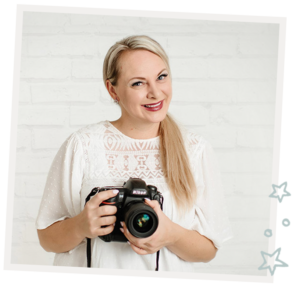
I'm
Lisa DiGeso
I’m on a mission to create uplifting online experiences for photographers ready to elevate their art, their business and their mindset.(...and have fun along the way!)

